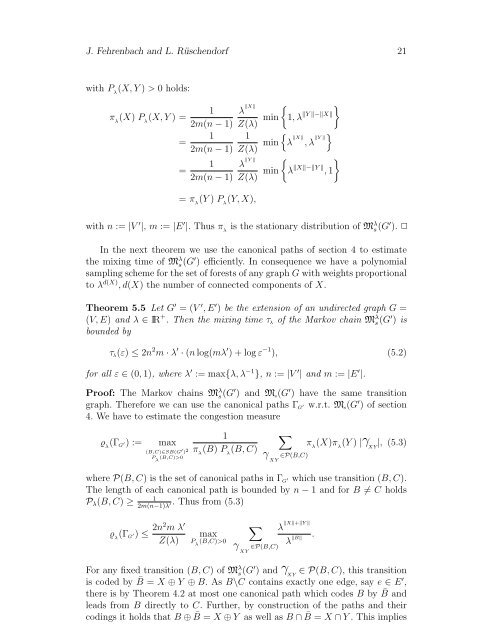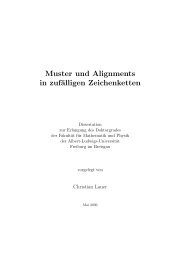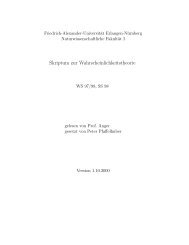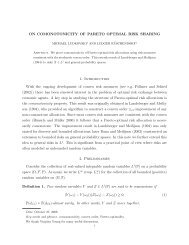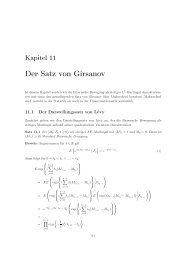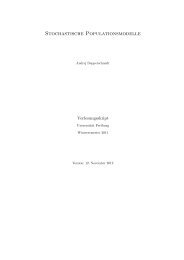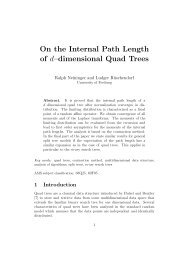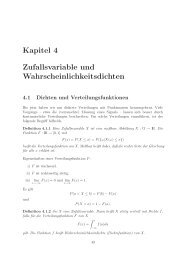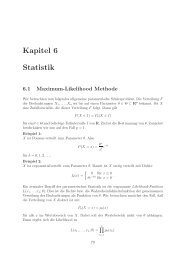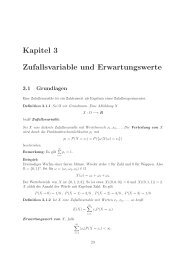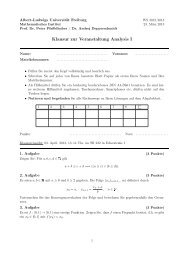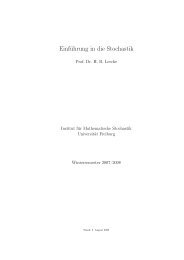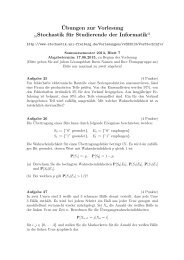Analysis of Markov chain algorithms on spanning trees, rooted ...
Analysis of Markov chain algorithms on spanning trees, rooted ...
Analysis of Markov chain algorithms on spanning trees, rooted ...
You also want an ePaper? Increase the reach of your titles
YUMPU automatically turns print PDFs into web optimized ePapers that Google loves.
J. Fehrenbach and L. Rüschendorf 21<br />
with P λ<br />
(X, Y ) > 0 holds:<br />
π λ<br />
(X) P λ<br />
(X, Y ) =<br />
=<br />
=<br />
1<br />
2m(n − 1)<br />
1<br />
2m(n − 1)<br />
1<br />
2m(n − 1)<br />
= π λ<br />
(Y ) P λ<br />
(Y, X),<br />
{ }<br />
λ ‖X‖<br />
Z(λ) min 1, λ ‖Y ‖−‖X‖<br />
1<br />
{<br />
Z(λ) min λ ‖X‖ , λ<br />
‖Y ‖}<br />
{<br />
λ ‖Y ‖<br />
Z(λ) min λ ‖X‖−‖Y ‖ , 1<br />
}<br />
with n := |V ′ |, m := |E ′ |. Thus π λ<br />
is the stati<strong>on</strong>ary distributi<strong>on</strong> <str<strong>on</strong>g>of</str<strong>on</strong>g> M λ s (G ′ ). ✷<br />
In the next theorem we use the can<strong>on</strong>ical paths <str<strong>on</strong>g>of</str<strong>on</strong>g> secti<strong>on</strong> 4 to estimate<br />
the mixing time <str<strong>on</strong>g>of</str<strong>on</strong>g> M λ s (G ′ ) efficiently. In c<strong>on</strong>sequence we have a polynomial<br />
sampling scheme for the set <str<strong>on</strong>g>of</str<strong>on</strong>g> forests <str<strong>on</strong>g>of</str<strong>on</strong>g> any graph G with weights proporti<strong>on</strong>al<br />
to λ d(X) , d(X) the number <str<strong>on</strong>g>of</str<strong>on</strong>g> c<strong>on</strong>nected comp<strong>on</strong>ents <str<strong>on</strong>g>of</str<strong>on</strong>g> X.<br />
Theorem 5.5 Let G ′ = (V ′ , E ′ ) be the extensi<strong>on</strong> <str<strong>on</strong>g>of</str<strong>on</strong>g> an undirected graph G =<br />
(V, E) and λ ∈ IR + . Then the mixing time τ λ <str<strong>on</strong>g>of</str<strong>on</strong>g> the <str<strong>on</strong>g>Markov</str<strong>on</strong>g> <str<strong>on</strong>g>chain</str<strong>on</strong>g> M λ s (G ′ ) is<br />
bounded by<br />
τ λ (ε) ≤ 2n 2 m · λ ′ · (n log(mλ ′ ) + log ε −1 ), (5.2)<br />
for all ε ∈ (0, 1), where λ ′ := max{λ, λ −1 }, n := |V ′ | and m := |E ′ |.<br />
Pro<str<strong>on</strong>g>of</str<strong>on</strong>g>: The <str<strong>on</strong>g>Markov</str<strong>on</strong>g> <str<strong>on</strong>g>chain</str<strong>on</strong>g>s M λ s (G ′ ) and M s (G ′ ) have the same transiti<strong>on</strong><br />
graph. Therefore we can use the can<strong>on</strong>ical paths Γ G<br />
′ w.r.t. M s (G ′ ) <str<strong>on</strong>g>of</str<strong>on</strong>g> secti<strong>on</strong><br />
4. We have to estimate the c<strong>on</strong>gesti<strong>on</strong> measure<br />
ϱ λ<br />
(Γ G<br />
′) :=<br />
max<br />
(B,C)∈SB(G ′ ) 2<br />
P λ<br />
(B,C)>0<br />
1<br />
π λ<br />
(B) P λ<br />
(B, C)<br />
∑<br />
γ<br />
XY<br />
∈P(B,C)<br />
π λ<br />
(X)π λ<br />
(Y ) |γ<br />
XY<br />
|, (5.3)<br />
where P(B, C) is the set <str<strong>on</strong>g>of</str<strong>on</strong>g> can<strong>on</strong>ical paths in Γ G<br />
′ which use transiti<strong>on</strong> (B, C).<br />
The length <str<strong>on</strong>g>of</str<strong>on</strong>g> each can<strong>on</strong>ical path is bounded by n − 1 and for B ≠ C holds<br />
1<br />
P λ (B, C) ≥ . Thus from (5.3)<br />
2m(n−1)λ ′<br />
ϱ λ<br />
(Γ G<br />
′) ≤ 2n2 m λ ′<br />
Z(λ)<br />
max<br />
P λ (B,C)>0<br />
∑<br />
γ<br />
XY<br />
∈P(B,C)<br />
λ ‖X‖+‖Y ‖<br />
λ ‖B‖ .<br />
For any fixed transiti<strong>on</strong> (B, C) <str<strong>on</strong>g>of</str<strong>on</strong>g> M λ s (G ′ ) and γ<br />
XY<br />
∈ P(B, C), this transiti<strong>on</strong><br />
is coded by ¯B = X ⊕ Y ⊕ B. As B\C c<strong>on</strong>tains exactly <strong>on</strong>e edge, say e ∈ E ′ ,<br />
there is by Theorem 4.2 at most <strong>on</strong>e can<strong>on</strong>ical path which codes B by ¯B and<br />
leads from B directly to C. Further, by c<strong>on</strong>structi<strong>on</strong> <str<strong>on</strong>g>of</str<strong>on</strong>g> the paths and their<br />
codings it holds that B ⊕ ¯B = X ⊕ Y as well as B ∩ ¯B = X ∩ Y . This implies


